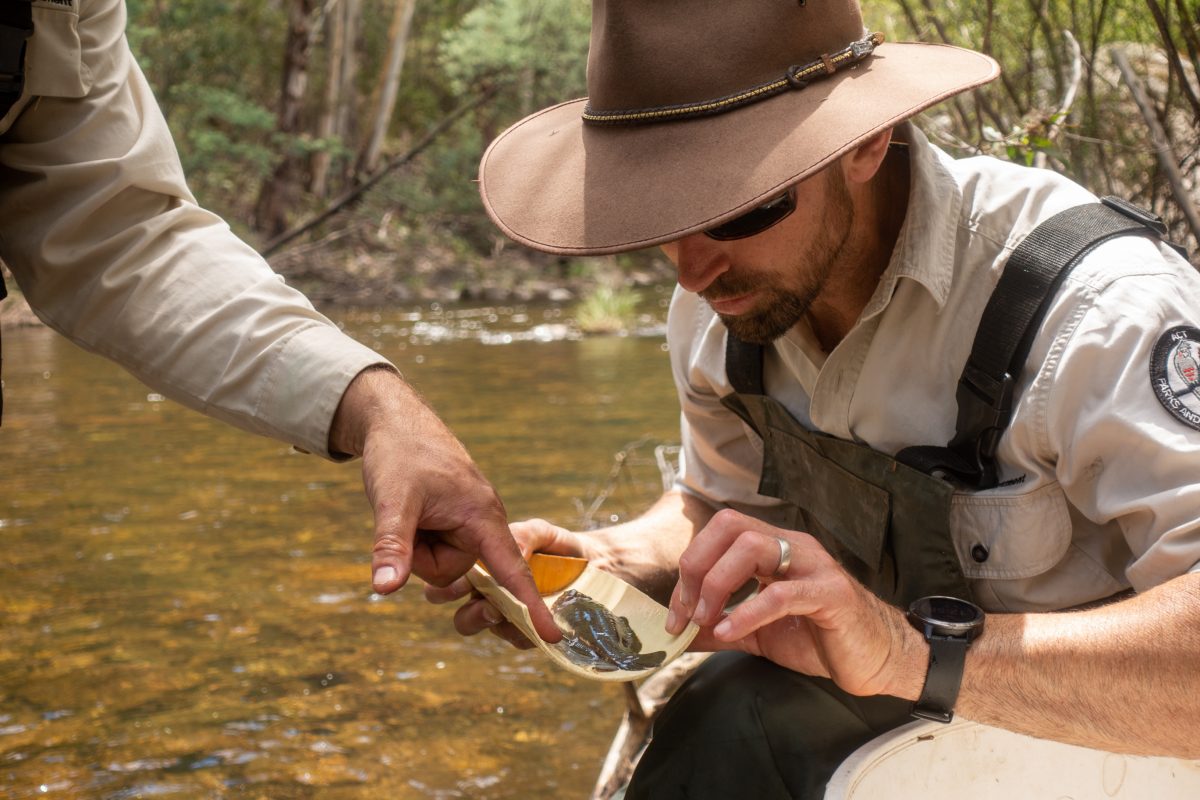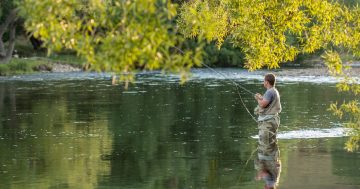
ACT Government aquatic ecologists inspect small two-spined blackfish as part of their monitoring program. Photo: Mark Jekabsons.
Trout fishing has always been contentious in the Australian angling community, with some fishers valuing them as a catch and others concerned about the harm they cause as an invasive species.
When they arrived here from the US and Europe in the late 1800s, trout’s popularity grew quickly due to their great taste and the challenge it takes to reel them in.
Unfortunately, that fighting spirit makes them a fierce competitor, and at times a predator, to native fish species.
The ACT Government treats them as an introduced species in their waterways, but there has been concern from University of Canberra (UC) ecologists that not enough is being done to control trout populations in the Cotter Reservoir.
According to Environment, Planning and Sustainable Development Directorate (EPSDD) aquatic ecologist Matthew Beitzel, trout usually coexist with native species but when the environment is in a poor state they have been known to eat them.
The fish especially of concern are the Macquarie perch and two-spined blackfish, and a group of fish known as galaxias. Mr Beitzel says galaxias are small freshwater fish, found in cooler areas. Threatened species of galaxias are found in NSW and Victoria, but not in the Territory.
However, since the completion of the Enlarged Cotter Reservoir in 2010, UC ecologists have noted in their annual monitoring reports the damage made by brown and rainbow trout on the dam and the upstream section of the Cotter River.

Pictured is a rainbow trout, which, with its brown counterpart, particularly benefits from the operation of large dams. The downstream release of cold water arriving out of the lower levels of the water body gives them a suitable habitat to rest and breed. Photo: ACT EPSDD.
While last year’s native fish impact report was corrupted by the large amounts of water released from the Cotter Dam during the monitoring period, the 2022 report and its predecessor recommended installing systems that could limit trout populations.
This is due to their belief that the size and numbers of these fish would grow over time, which in the crowded environment would motivate them to start eating the native river species.
From EPSDD assessments of fish guts taken from the Cotter River, Mr Beitzel says trout are known to have eaten the blackfish but officials haven’t detected any cases of the same happening to Macquarie perch younglings.
Mr Beitzel says the ACT Government deals with trout like other invasive species in its animal and plant pest management plans. Instead of their numbers, they reduce the damage they cause.
However, he acknowledges the Cotter catchment is the closest trout fishing location to Canberra and is important to fishers.

Earthworks being done on the Enlarged Cotter Dam project. Photo: Mark Jekabsons.
Many consider the waterways around Canberra to be unique in the Australian fishing world, due to their ability to host both trout and native species.
ACT Fishos vice-president Glen Malam says the warmer lakes and rivers closer to Canberra are particularly suited to native fish, “while the cold alpine lakes up in the Snowy Mountains scheme are a great environment for trout”.
Near Tumut, this distinction can be seen a few metres apart, he says.
“You’ve got the very deep Lake Talbingo, which is quite good for trout. Then immediately below it is Jounama Pondage, which is part of the pumping cycle of the Snowy scheme and where you can get native fish,” Mr Malam says.
He believes this provides the ACT with an opportunity for everyone to be satisfied. Populate the colder creeks and rivers with trout, and leave the warmer waterways for native fish.














